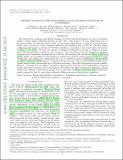| dc.contributor.author | Fraine, Jonathan D. | |
| dc.contributor.author | Deming, Drake | |
| dc.contributor.author | Demory, Brice-Olivier | |
| dc.contributor.author | Benneke, Bjoern | |
| dc.contributor.author | Seager, Sara | |
| dc.contributor.author | Knutson, Heather A. | |
| dc.contributor.author | Desert, Jean-Michel | |
| dc.contributor.author | Lewis, Nikole | |
| dc.contributor.author | Gillon, M. | |
| dc.contributor.author | Jehin, Emmanuel | |
| dc.date.accessioned | 2014-04-11T17:13:23Z | |
| dc.date.available | 2014-04-11T17:13:23Z | |
| dc.date.issued | 2013-02 | |
| dc.date.submitted | 2012-10 | |
| dc.identifier.issn | 0004-637X | |
| dc.identifier.issn | 1538-4357 | |
| dc.identifier.uri | http://hdl.handle.net/1721.1/86115 | |
| dc.description.abstract | We observed the transiting super-Earth exoplanet GJ1214b using warm Spitzer at 4.5 μm wavelength during a 20 day quasi-continuous sequence in 2011 May. The goals of our long observation were to accurately define the infrared transit radius of this nearby super-Earth, to search for the secondary eclipse, and to search for other transiting planets in the habitable zone of GJ1214. We here report results from the transit monitoring of GJ1214b, including a reanalysis of previous transit observations by Désert et al. In total, we analyze 14 transits of GJ1214b at 4.5 μm, 3 transits at 3.6 μm, and 7 new ground-based transits in the I+z band. Our new Spitzer data by themselves eliminate cloudless solar composition atmospheres for GJ1214b, and methane-rich models from Howe & Burrows. Using our new Spitzer measurements to anchor the observed transit radii of GJ1214b at long wavelengths, and adding new measurements in I+z, we evaluate models from Benneke & Seager and Howe & Burrows using a χ[superscript 2] analysis. We find that the best-fit model exhibits an increase in transit radius at short wavelengths due to Rayleigh scattering. Pure water atmospheres are also possible. However, a flat line (no atmosphere detected) remains among the best of the statistically acceptable models, and better than pure water atmospheres. We explore the effect of systematic differences among results from different observational groups, and we find that the Howe & Burrows tholin-haze model remains the best fit, even when systematic differences among observers are considered. | en_US |
| dc.description.sponsorship | United States. National Aeronautics and Space Administration | en_US |
| dc.language.iso | en_US | |
| dc.publisher | IOP Publishing | en_US |
| dc.relation.isversionof | http://dx.doi.org/10.1088/0004-637X/765/2/127 | en_US |
| dc.rights | Creative Commons Attribution-Noncommercial-Share Alike | en_US |
| dc.rights.uri | http://creativecommons.org/licenses/by-nc-sa/4.0/ | en_US |
| dc.source | arXiv | en_US |
| dc.title | SPITZER TRANSITS OF THE SUPER-EARTH GJ1214b AND IMPLICATIONS FOR ITS ATMOSPHERE | en_US |
| dc.type | Article | en_US |
| dc.identifier.citation | Fraine, Jonathan D., Drake Deming, Michael Gillon, Emmanuel Jehin, Brice-Olivier Demory, Bjoern Benneke, Sara Seager, Nikole K. Lewis, Heather Knutson, and Jean-Michel Desert. “ SPITZER TRANSITS OF THE SUPER-EARTH GJ1214b AND IMPLICATIONS FOR ITS ATMOSPHERE .” The Astrophysical Journal 765, no. 2 (March 10, 2013): 127. | en_US |
| dc.contributor.department | Massachusetts Institute of Technology. Department of Earth, Atmospheric, and Planetary Sciences | en_US |
| dc.contributor.department | Massachusetts Institute of Technology. Department of Physics | en_US |
| dc.contributor.mitauthor | Demory, Brice-Olivier | en_US |
| dc.contributor.mitauthor | Benneke, Bjoern | en_US |
| dc.contributor.mitauthor | Seager, Sara | en_US |
| dc.contributor.mitauthor | Lewis, Nikole | en_US |
| dc.relation.journal | The Astrophysical Journal | en_US |
| dc.eprint.version | Author's final manuscript | en_US |
| dc.type.uri | http://purl.org/eprint/type/JournalArticle | en_US |
| eprint.status | http://purl.org/eprint/status/PeerReviewed | en_US |
| dspace.orderedauthors | Fraine, Jonathan D.; Deming, Drake; Gillon, Michael; Jehin, Emmanuel; Demory, Brice-Olivier; Benneke, Bjoern; Seager, Sara; Lewis, Nikole K.; Knutson, Heather; Desert, Jean-Michel | en_US |
| dc.identifier.orcid | https://orcid.org/0000-0002-6892-6948 | |
| mit.license | OPEN_ACCESS_POLICY | en_US |
| mit.metadata.status | Complete | |
